Cylindrical Roller Bearings
Startseite » Rolling bearings » Cylindrical roller bearings
Characteristics of Cylindrical Roller Bearings
Cylindrical roller bearings can support very high radial loads due to the line contact between the cylindrical rolling elements and the race. For this reason, cylindrical roller bearings are often used in gearboxes, as wheelset bearings of rail vehicles or as non-locating bearings in electric motors.
This type of bearing has a significantly higher load rating in an identical design envelope to ball bearings or tapered roller bearings. If the specific application requires even higher load ratings, full complement cylindrical roller bearings can be used in which more rolling elements are fitted in the same space, thus increasing the load rating. It should be noted that full complement designs generate higher friction due to the direct contact between the rolling elements. In order to keep heat generation due to friction as low as possible, care must be taken to ensure adequate lubrication. Despite the line contact characteristic of roller bearings, cylindrical roller bearings achieve the highest limiting speeds compared to many other roller bearings, although these are lower than those of ball bearings. Furthermore, in certain designs, the rollers on the inner and outer rings are axially displaceable. This feature provides higher rigidity, lower friction and longer life.
Design of Cylindrical Roller Bearings
Cylindrical roller bearings consist of solid outer rings, inner rings and cages, which are equipped with a large number of cylindrical rollers. Compared to other types of rolling bearings, cylindrical roller bearings may also have flanges. These flanges are often integrated directly into the inner and/or outer ring of the bearing. The flanges are used to guide the rollers or cylinders on one or both rings. Thus, in all standard designs, the cylindrical rollers are always guided by at least one bearing ring between fixed flanges.
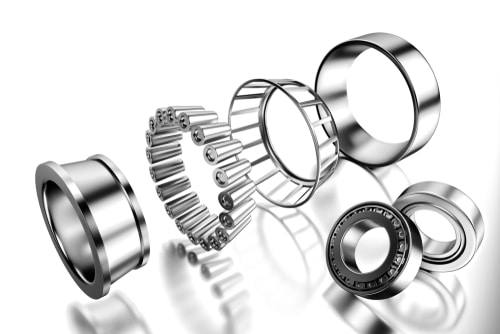
The cylindrical rollers and the inner and outer ring are made of rolling bearing steel. Cylindrical roller bearings are also available in sealed or split designs. In sealed bearings, the rollers are protected against dirt, water and dust, keeping the lubricant in the bearing and ensuring that contaminants do not enter the bearing. It also allows for lower friction and longer service life. Split bearings are primarily intended for bearing arrangements that are difficult to access (e.g. crankshafts) and allow simplification of maintenance and replacement.
The different designs of the Cylindrical Roller Bearings
Single row Cylindrical Roller Bearings with cage
Single row cylindrical roller bearings with cage are units consisting of solid, outer and inner rings and cylindrical roller and cage assemblies. Due to their rigid design and the line contact between the rollers and grooves, they are designed for much higher radial loads than ball bearings of identical design, but the axial load carrying capacity is limited by the bearing design. Parallel to the high radial load carrying capacity, they allow high speeds and are therefore predestined for high-speed applications. 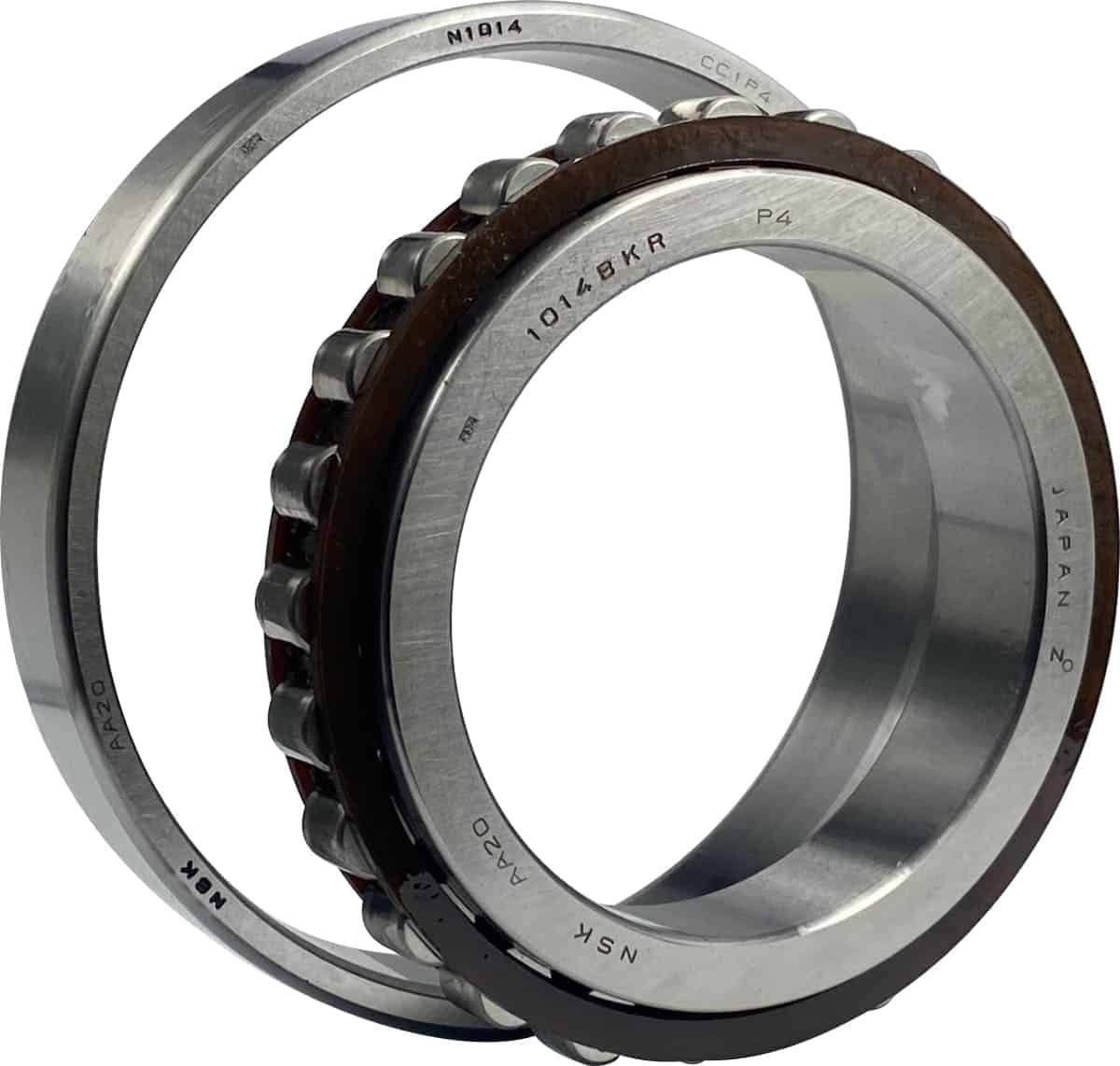
Single row cylindrical roller bearings are available in many designs, series and sizes. They are therefore differentiated according to the following criteria:
- Design and material of the cage
- Number and arrangement of flanges on inner and outer ring
The most common designs of single row cylindrical roller bearings are NU and N. In NU bearings, the outer ring has two fixed shelves, whereas the smooth inner ring is designed without flanges. In N bearings, on the other hand, the two fixed flanges are on the inner ring and the outer ring is flangless. Due to the lack of flanges, displacement of the shaft relative to the housing in the axial direction is possible and allows the bearing to function as a non-locating bearing.
In addition to two fixed flanges on the outer ring, NJ bearings have one fixed rib on the inner ring, which enables axial displacement in one direction and thus allows the bearing to be used as a support bearing.
NUP bearings have, in addition to two fixed flangeson the outer ring, a fixed rib on the inner ring and a flanged washer (P), which together no longer allow axial displacement and thus ensure use as a locating bearing.
The single-row cylindrical roller bearings are only suitable to a limited extent for compensating misalignments. The permissible misalignment between the inner and outer ring depends on the bearing size, the internal design of the bearing, the operating clearance and the acting forces and moments. Misalignments lead to an awkward rolling of the rolling elements and demand additional stresses in the bearing that reduce the operating life.
Single row, full complement Cylindrical Roller Bearings
Single row, full complement cylindrical roller bearings can support the highest radial forces due to the largest possible number of rolling elements. The bearings are very stiff and are particularly predestined for space-saving designs. The limiting speeds of full complement bearings are significantly lower than those of caged cylindrical roller bearings. Single row full complement cylindrical roller bearings can be dismantled and are therefore easy to mount and dismount. They are suitable for low speed requirements and only allow limited compensation for angular misalignment.
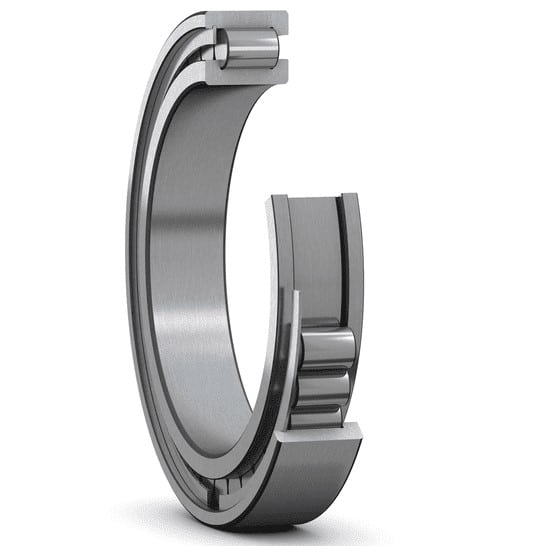
Single row, full complement cylindrical roller bearings are separable and non-self-retaining bearings, which are subdivided into the designs NCF and NJG. In NCF bearings, the inner ring has two fixed flanges, whereas the outer ring has one fixed rib. A locking plate on the flangeless side of the outer ring prevents the rollers from falling out when assembled. However, it is important to note that full complement cylindrical roller bearings are not necessarily designed to be self-retaining. Disassembly can therefore cause the rolling elements to fall out. Attention must be paid to the suffixes.
NJG bearings, on the other hand, have two fixed flanges on the outer ring and one on the inner ring. This type of bearing has a self-retaining roller set, which facilitates the mounting and dismounting of the bearing. Both types have the ability to absorb axial forces on one side and are used as support bearings. The single-sided fixed rib enables axial guidance of the shaft relative to the housing in one direction.
Single row, full complement cylindrical roller bearings are suitable for supporting the highest radial forces and have a particularly high radial rigidity. They are only suitable to a limited extent for compensating misalignments. The permissible misalignment between the inner and outer ring depends on the bearing size, the internal design of the bearing, the operating clearance and the acting forces and moments. Misalignments have the consequence that the rolling elements run more unfavourably and cause additional stresses in the bearing, which reduce the operating life.
Double row Cylindrical Roller Bearings with cage
Double row cylindrical roller bearings with cage are suitable for considerably higher radial loads than single row cylindrical roller bearings due to their rigid design and the line contact between the rollers and grooves. In addition to the high radial load carrying capacity, they are designed for medium to high speeds. Double-row cylindrical roller bearings with cage can be divided into two basic designs, which are distinguished by the position of the flanges on the inner ring or outer ring. They can also be dismantled and are therefore easy to fit and remove. They are suitable for medium to high speed requirements, are particularly tilt-resistant and do not allow compensation for angular misalignment.
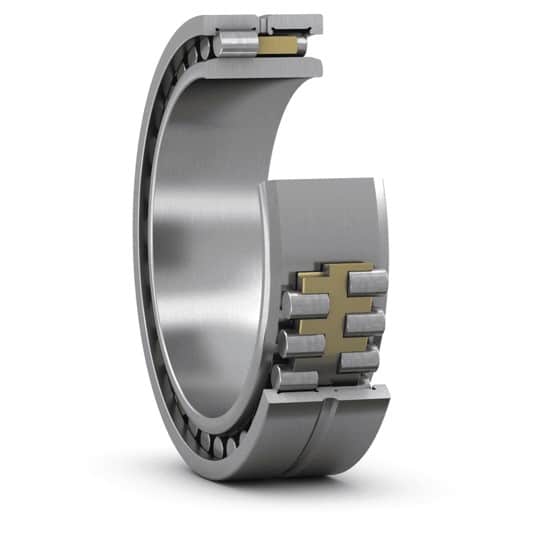
Double-row cylindrical roller bearings with cage can be divided into the basic designs NNU and NN. In NNU bearings, the outer ring has three fixed flanges , whereas the inner ring has no flanges. NN bearings have three fixed flanges on the inner ring, while the outer ring is flangeless. In general, cylindrical roller bearings can be supplied with a cylindrical or tapered bore. The ribless design of the races in both types of bearings allows the shaft to be displaced relative to the housing in the axial direction. The compensation of the displacement or longitudinal expansion of the shaft takes place without constraint in the bearing, so that a sliding fit in the housing or on the shaft is not necessary.
Double-row cylindrical roller bearings are unsuitable for compensating misalignments. This is because misalignments lead to increased edge pressure between the rolling element and the groove and cause additional stresses in the bearing that reduce the operating life.
Double row, full complement Cylindrical Roller Bearings
Double-row, full complement cylindrical roller bearings can support the highest radial forces with the help of the largest possible number of rolling elements. The bearings are extremely rigid and are predestined for use in space-saving designs. The limiting speeds of full complement bearings are significantly lower than those of cylindrical roller bearings with cages. Double row full complement cylindrical roller bearings can be dismantled and are therefore easy to mount and dismount. They are ideally suited for low speed requirements and do not allow compensation for angular misalignment.
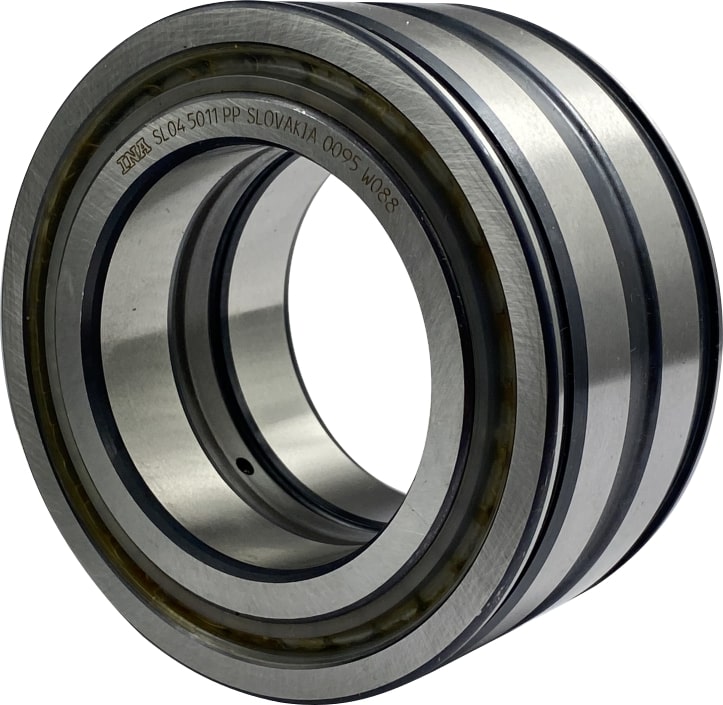
Overall, this type of bearing can be divided into the designs NNC, NNCL, NNCF and ACB. In NNC bearings, the inner ring has three fixed flanges, a fixed flange and a loose flanged washer on the outer ring. They are able to support axial forces on both sides and are therefore suitable for use as locating bearings. Direct support of the loose flanged washer by a conversion design is the prerequisite for axial force absorption on both sides.
NNCL bearings, on the other hand, have three fixed flanges on the inner ring and a ribless outer ring with two retaining rings. The absence of the flanges allows axial displacement of the shaft relative to the housing, so that the bearing can be used as a non-locating bearing. In NNCF bearings, the inner ring has three fixed flanges as well as a flange on the outer ring, which enables axial force to be absorbed on one side.
Double-row, full complement cylindrical roller bearings are unsuitable for compensating misalignments. Misalignments lead to increased edge pressure between the rolling element and the groove and cause additional stresses in the bearing that reduce the operating life.
Multi-row Cylindrical Roller Bearings with cage
Multi-row cylindrical roller bearings with cage can support very high radial forces due to the linear contact between the rolling element and bearing ring and the high number of rolling elements through several rows. They can be differentiated into two designs, which are differentiated by a pitch of the inner ring. Multi-row cylindrical roller bearings can be dismantled and are therefore easy to mount and dismount. They are suitable for high speed requirements, but do not allow compensation of angular misalignments.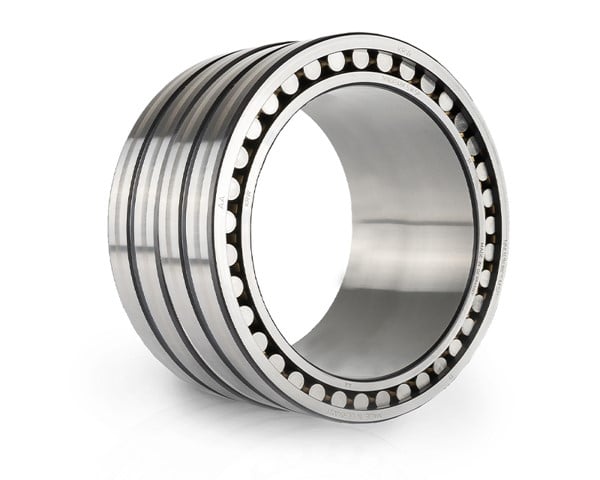 Multi-row cylindrical roller bearings with cage can be divided into the two designs NU60 and NNU60. Both designs have four bearing rows guided by four fixed flanges on two outer rings. NNU bearings have two inner rings without flanges, whereas NU60 bearings have one inner ring without flanges. This absence of flanges on the inner ring ensures that displacement of the shaft relative to the housing in the axial direction is possible and allows the bearing to act as a non-locating bearing. The compensation of the longitudinal expansion takes place without constraint, so that a sliding fit in the housing is not necessary. Multi-row cylindrical roller bearings are not suitable for compensating misalignments. Misalignments lead to increased edge pressure between the rolling element and the groove and cause additional stresses around the bearing that reduce the operating life.
Multi-row cylindrical roller bearings with cage can be divided into the two designs NU60 and NNU60. Both designs have four bearing rows guided by four fixed flanges on two outer rings. NNU bearings have two inner rings without flanges, whereas NU60 bearings have one inner ring without flanges. This absence of flanges on the inner ring ensures that displacement of the shaft relative to the housing in the axial direction is possible and allows the bearing to act as a non-locating bearing. The compensation of the longitudinal expansion takes place without constraint, so that a sliding fit in the housing is not necessary. Multi-row cylindrical roller bearings are not suitable for compensating misalignments. Misalignments lead to increased edge pressure between the rolling element and the groove and cause additional stresses around the bearing that reduce the operating life.
Multi-row, full complement Cylindrical Roller Bearings
Multi-row, full complement cylindrical roller bearings can support the highest radial forces due to the largest possible number of rolling elements. The bearings are radially very stiff and are particularly suitable for space-saving designs. The limiting speeds of full complement cylindrical roller bearings are significantly lower than those of caged cylindrical roller bearings. Multi-row full complement cylindrical roller bearings can be dismantled, are suitable for low speed requirements and do not allow compensation for angular misalignment. Multi-row full complement cylindrical roller bearings are not suitable for compensating misalignments. These lead to increased edge pressure between the rolling element and the groove and cause additional stresses in the bearing that reduce the operating life.
Axial Cylindrical Roller Bearings
Axial Cylindrical Roller Bearings, single direction
Single direction axial cylindrical roller bearings, which consist of a shaft locating washer, a housing locating washer and an axial cylindrical roller and cage assembly, can support high single direction axial loads, but not radial loads. They are separable, non-self-retaining bearings. As an alternative to an externally centred housing locating washer or an internally centred shaft locating washer, a track locating washer can also be used if exact centring is not required. The logarithmic profiling of the cylindrical rollers prevents harmful edge stresses and thus premature failure.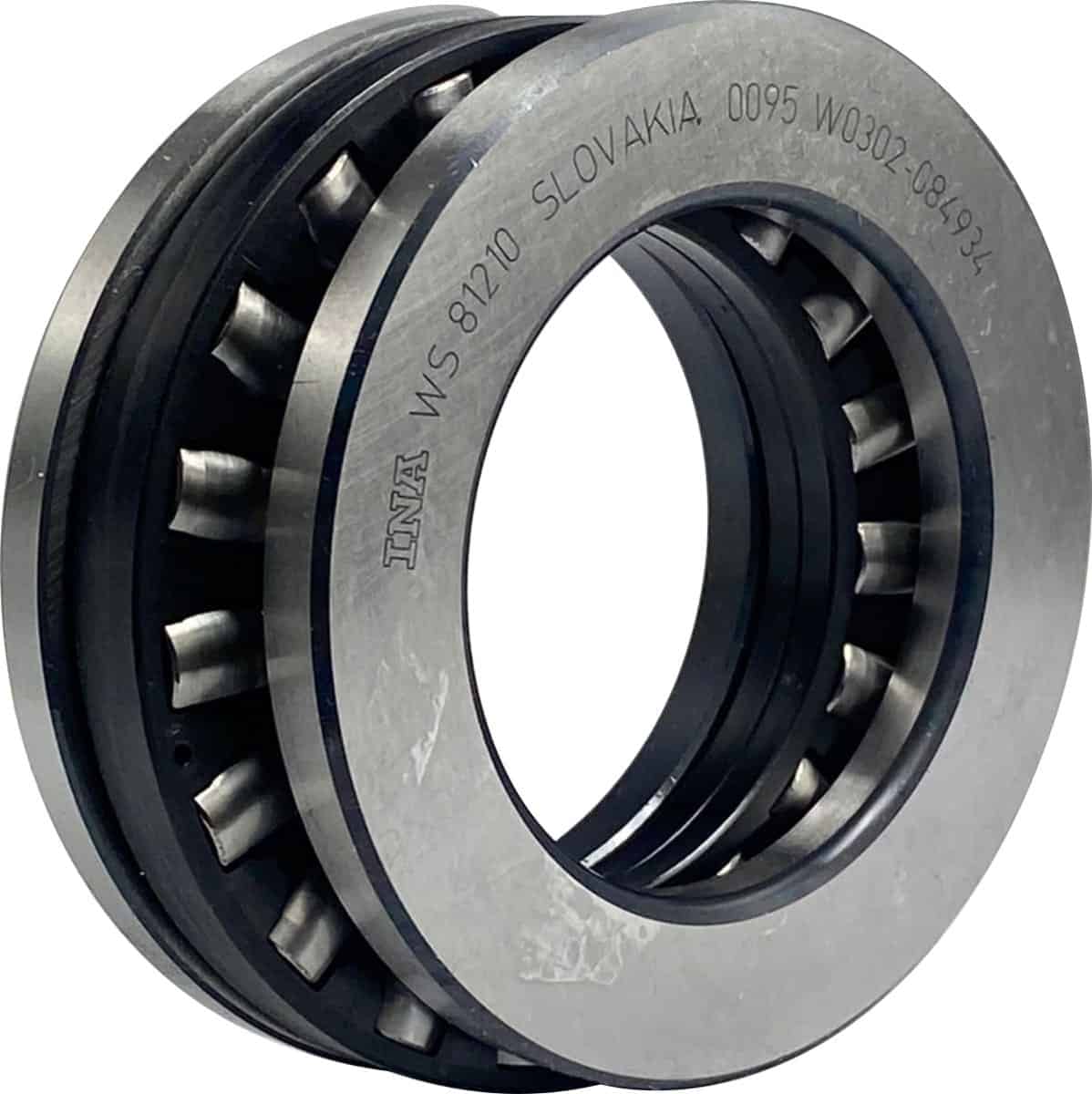 Axial cylindrical roller bearings are not suitable for compensating misalignments. Misalignments lead to increased edge pressure between the rolling element and the groove and cause additional stresses in the bearing which reduce the operating life.
Axial cylindrical roller bearings are not suitable for compensating misalignments. Misalignments lead to increased edge pressure between the rolling element and the groove and cause additional stresses in the bearing which reduce the operating life.
Axial Cylindrical Roller Bearings, double direction
Double direction cylindrical roller thrust bearings consist of a shaft locating washer, two housing locating washers and two cylindrical roller and cage assemblies, which can support high axial loads acting on both sides, but not radial loads. They are not self-retaining, so roller and cage assemblies and bearing washers can be mounted independently of each other. Alternatively to the externally centred housing washer or the internally centred shaft washer, a running washer can also be used, which is applied when exact centring is not necessary. The logarithmic profiling of the cylindrical rollers prevents harmful edge stresses and thus premature failure. Axial cylindrical roller bearings are not suitable for compensating misalignments. Misalignments cause increased edge pressure between the rolling element and the groove and cause additional stresses in the bearing that reduce the operating life.
PACH Systems offers you a wide product range of different cylindrical roller bearings. For this purpose, we work together with our long-standing partners. Please let us know your requirements via our contact form. We will be happy to provide you with a non-binding offer or contact you to discuss the details.


